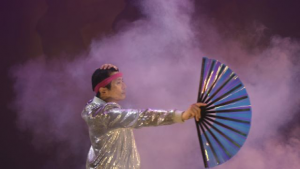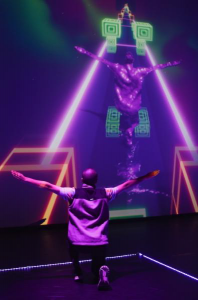Form Dance Projects. Riverside Theatres, Lennox Theatre. 11-13 August, 2022
Reviewed : 11 August, 2022*

Form Dance continues to bring new and unusual works to Sydney audiences. The presentations in this program tick both boxes. One is more traditional, the other radically twenty-first century. Both link performance and technology. Both will have different audience appeal – and response.
Fall, Falter, Dance!
Alone on the stage Ryuichi Fujimura stands, microphone in hand, and begins his stories – stories with which so many performers can identify. Stories of inspiration and rejection, motivation and failure – and the determination to keep trying, keep moving on … dancing!
Though it is an oft’ told tale, Fujimura presents it in a different way. Fujimura the actor knows how to introduce humour – and pathos. Fujimura the dancer knows when to intersperse his words with carefully devised dance routines. Fujimura the performer knows exactly when to use stillness and silence. In words and movement, he expressively leads the audience through a range of emotional responses.
Fujimura uses a bare stage, a microphone, a dance bag and a backdrop screen on which the vacant eyes of his past loom above him. Directors, choreographers … audiences. Screens and clever graphics have become synonymous with arts performances. Fujimura uses his screen to emphasise the harrowing distance between talent, hard work, and recognition in the arts.
This story is not new – but Fujimura, the way he tells it is different, at times raw, at times funny, at times sad. It is the story of dancer, but its appeal reaches into all areas of the arts. From dancers facing yet another call back, to actors waiting in the wings for yet another audition., to painters carrying their works from gallery to gallery in hope of a chance to exhibit. to all the talented people who just want a chance to have their talent recognised.
Beatstorm

Beatstorm is a different thing altogether. Described as a collision between a video game and a movement performance, its appeal is to the generations who have grown up with screens and buttons and fast-moving eyes and fingers. The best way to describe it is to use the words of the program – because they do it far more graphically:
“Motion capture devices trach and project two players into a virtual world in real time as they travel along a fast-moving path set to high-energy electronic dance music evocative of video gaming. In each level players must doge a barrage of obstacles and collect items by moving their bodies; there is a one-to-one correspondence of movement between the real and the virtual”.
See what I mean! It is far beyond the ability of someone who is not au fait with that world to try to explain or follow – but well and truly pertinent for those who identify strongly with the concentration, skill, speed and energy of Chris Chua and Nasim Patel, who demonstrated Chua’s incredible creation.
Chris Chua has a creative imagination, obviously inspired by his work in computer programming and his dance experience. Bringing them together in such a creative way is an inspiration – and one that will appeal enormously across generations. Imagine the possibilities when Chua’s idea is picked up by a wily entrepreneur. Beatstorm arcades or academies? Beatstorm fitness gyms? Beatstorm competitive events? The Olympics perhaps?
Beatstorm’s appeal is to the young and fit. It is not a ‘performance’ that appeals to the usual dance audience. It does, however, have appeal to those want to merge fitness, movement and the virtual world. That’s a commercial possibility that Chua should be peddling widely.
First published in Stage Whispers magazine
*Opening performance